Development of the Welfare State since Poor Law Amendment Act 1834 - BSc (Hons) in Health and Social Care
VerifiedAdded on 2023/06/07
|12
|3561
|128
AI Summary
This article explores the timeline of the development of the welfare state since the Poor Law Amendment Act 1834. It covers the policies and legislations impacting trade unions and the consensus politics that led to the development of the welfare state. The article is relevant to BSc (Hons) in Health and Social Care students taking the HSO4002 Social Policy module.
Contribute Materials
Your contribution can guide someone’s learning journey. Share your
documents today.

Development of the Welfare State since Poor Law
Amendment Act 1834
Course name: BSc (Hons) in Health and Social Care
Cohort
Module Code: HSO4002
Module Title: Social Policy
Marking tutor
Submission deadline
Student ID Number:
Amendment Act 1834
Course name: BSc (Hons) in Health and Social Care
Cohort
Module Code: HSO4002
Module Title: Social Policy
Marking tutor
Submission deadline
Student ID Number:
Secure Best Marks with AI Grader
Need help grading? Try our AI Grader for instant feedback on your assignments.
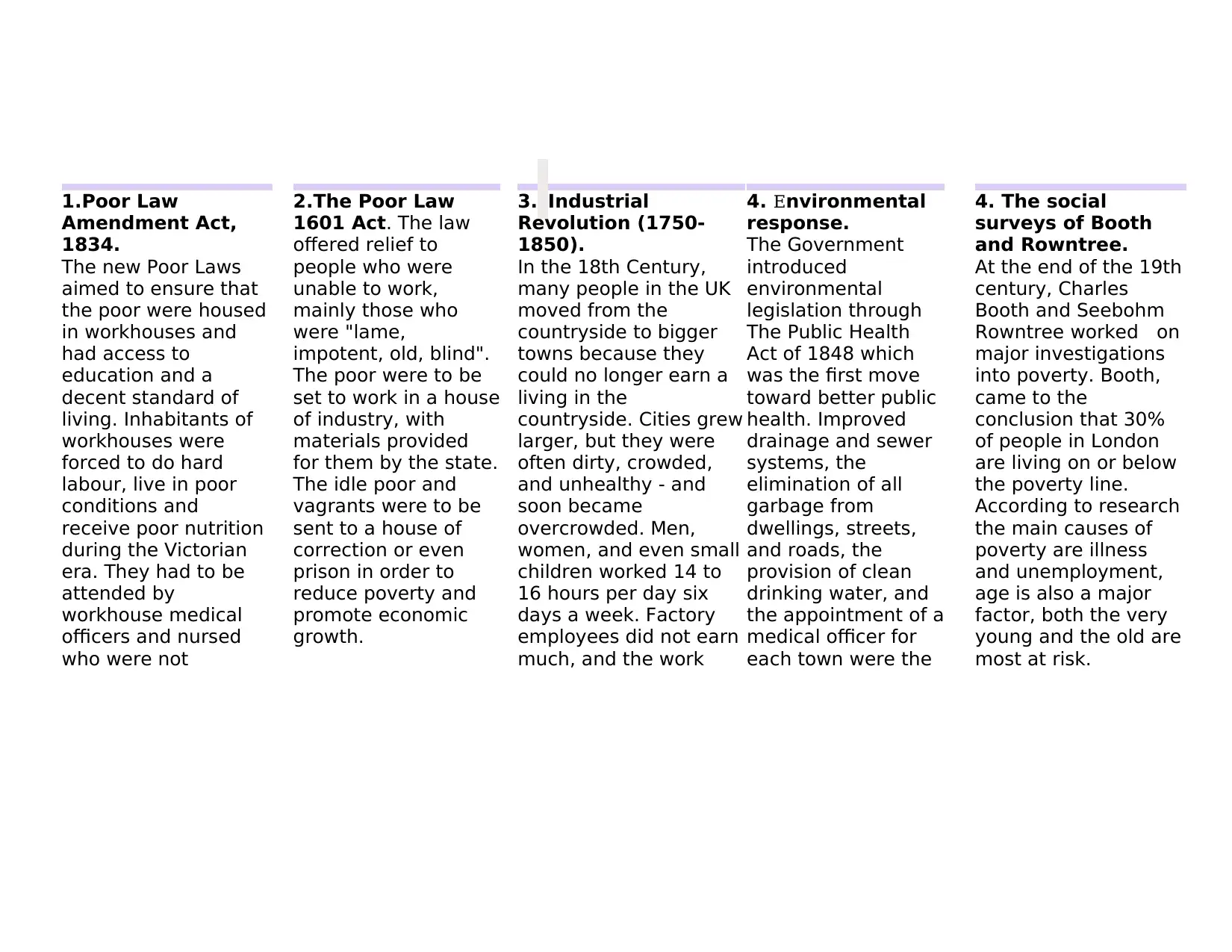
1.Poor Law
Amendment Act,
1834.
The new Poor Laws
aimed to ensure that
the poor were housed
in workhouses and
had access to
education and a
decent standard of
living. Inhabitants of
workhouses were
forced to do hard
labour, live in poor
conditions and
receive poor nutrition
during the Victorian
era. They had to be
attended by
workhouse medical
officers and nursed
who were not
qualified to look after
2.The Poor Law
1601 Act. The law
offered relief to
people who were
unable to work,
mainly those who
were "lame,
impotent, old, blind".
The poor were to be
set to work in a house
of industry, with
materials provided
for them by the state.
The idle poor and
vagrants were to be
sent to a house of
correction or even
prison in order to
reduce poverty and
promote economic
growth.
3. Industrial
Revolution (1750-
1850).
In the 18th Century,
many people in the UK
moved from the
countryside to bigger
towns because they
could no longer earn a
living in the
countryside. Cities grew
larger, but they were
often dirty, crowded,
and unhealthy - and
soon became
overcrowded. Men,
women, and even small
children worked 14 to
16 hours per day six
days a week. Factory
employees did not earn
much, and the work
was often dangerous.
4. Environmental
response.
The Government
introduced
environmental
legislation through
The Public Health
Act of 1848 which
was the first move
toward better public
health. Improved
drainage and sewer
systems, the
elimination of all
garbage from
dwellings, streets,
and roads, the
provision of clean
drinking water, and
the appointment of a
medical officer for
each town were the
most important
4. The social
surveys of Booth
and Rowntree.
At the end of the 19th
century, Charles
Booth and Seebohm
Rowntree worked on
major investigations
into poverty. Booth,
came to the
conclusion that 30%
of people in London
are living on or below
the poverty line.
According to research
the main causes of
poverty are illness
and unemployment,
age is also a major
factor, both the very
young and the old are
most at risk.
Amendment Act,
1834.
The new Poor Laws
aimed to ensure that
the poor were housed
in workhouses and
had access to
education and a
decent standard of
living. Inhabitants of
workhouses were
forced to do hard
labour, live in poor
conditions and
receive poor nutrition
during the Victorian
era. They had to be
attended by
workhouse medical
officers and nursed
who were not
qualified to look after
2.The Poor Law
1601 Act. The law
offered relief to
people who were
unable to work,
mainly those who
were "lame,
impotent, old, blind".
The poor were to be
set to work in a house
of industry, with
materials provided
for them by the state.
The idle poor and
vagrants were to be
sent to a house of
correction or even
prison in order to
reduce poverty and
promote economic
growth.
3. Industrial
Revolution (1750-
1850).
In the 18th Century,
many people in the UK
moved from the
countryside to bigger
towns because they
could no longer earn a
living in the
countryside. Cities grew
larger, but they were
often dirty, crowded,
and unhealthy - and
soon became
overcrowded. Men,
women, and even small
children worked 14 to
16 hours per day six
days a week. Factory
employees did not earn
much, and the work
was often dangerous.
4. Environmental
response.
The Government
introduced
environmental
legislation through
The Public Health
Act of 1848 which
was the first move
toward better public
health. Improved
drainage and sewer
systems, the
elimination of all
garbage from
dwellings, streets,
and roads, the
provision of clean
drinking water, and
the appointment of a
medical officer for
each town were the
most important
4. The social
surveys of Booth
and Rowntree.
At the end of the 19th
century, Charles
Booth and Seebohm
Rowntree worked on
major investigations
into poverty. Booth,
came to the
conclusion that 30%
of people in London
are living on or below
the poverty line.
According to research
the main causes of
poverty are illness
and unemployment,
age is also a major
factor, both the very
young and the old are
most at risk.
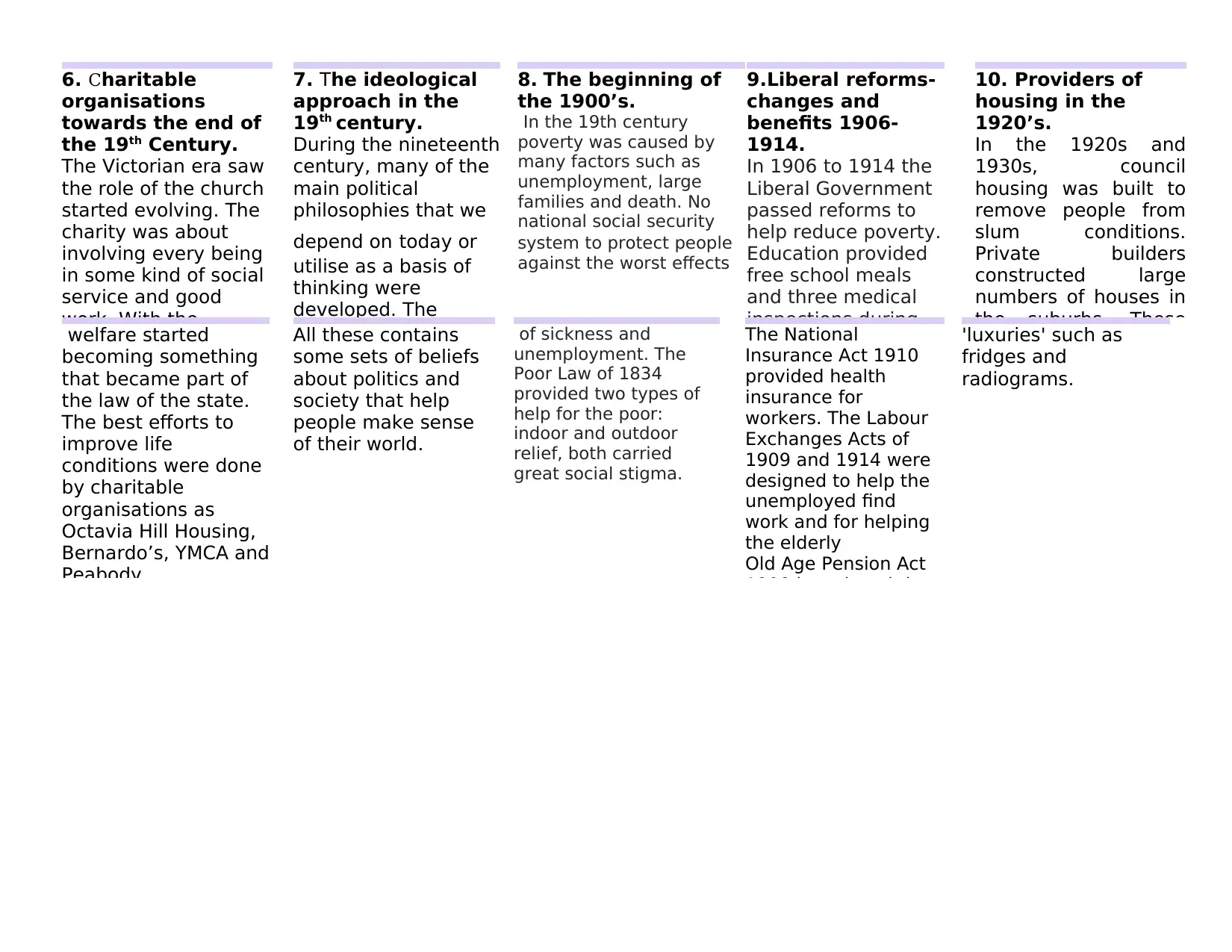
6. Charitable
organisations
towards the end of
the 19th Century.
The Victorian era saw
the role of the church
started evolving. The
charity was about
involving every being
in some kind of social
service and good
work. With the
7. The ideological
approach in the
19th century.
During the nineteenth
century, many of the
main political
philosophies that we
depend on today or
utilise as a basis of
thinking were
developed. The
8. The beginning of
the 1900’s.
In the 19th century
poverty was caused by
many factors such as
unemployment, large
families and death. No
national social security
system to protect people
against the worst effects
9.Liberal reforms-
changes and
benefits 1906-
1914.
In 1906 to 1914 the
Liberal Government
passed reforms to
help reduce poverty.
Education provided
free school meals
and three medical
inspections during
10. Providers of
housing in the
1920’s.
In the 1920s and
1930s, council
housing was built to
remove people from
slum conditions.
Private builders
constructed large
numbers of houses in
the suburbs. These
welfare started
becoming something
that became part of
the law of the state.
The best efforts to
improve life
conditions were done
by charitable
organisations as
Octavia Hill Housing,
Bernardo’s, YMCA and
Peabody.
All these contains
some sets of beliefs
about politics and
society that help
people make sense
of their world.
of sickness and
unemployment. The
Poor Law of 1834
provided two types of
help for the poor:
indoor and outdoor
relief, both carried
great social stigma.
The National
Insurance Act 1910
provided health
insurance for
workers. The Labour
Exchanges Acts of
1909 and 1914 were
designed to help the
unemployed find
work and for helping
the elderly
Old Age Pension Act
1908 introduced the
'luxuries' such as
fridges and
radiograms.
organisations
towards the end of
the 19th Century.
The Victorian era saw
the role of the church
started evolving. The
charity was about
involving every being
in some kind of social
service and good
work. With the
7. The ideological
approach in the
19th century.
During the nineteenth
century, many of the
main political
philosophies that we
depend on today or
utilise as a basis of
thinking were
developed. The
8. The beginning of
the 1900’s.
In the 19th century
poverty was caused by
many factors such as
unemployment, large
families and death. No
national social security
system to protect people
against the worst effects
9.Liberal reforms-
changes and
benefits 1906-
1914.
In 1906 to 1914 the
Liberal Government
passed reforms to
help reduce poverty.
Education provided
free school meals
and three medical
inspections during
10. Providers of
housing in the
1920’s.
In the 1920s and
1930s, council
housing was built to
remove people from
slum conditions.
Private builders
constructed large
numbers of houses in
the suburbs. These
welfare started
becoming something
that became part of
the law of the state.
The best efforts to
improve life
conditions were done
by charitable
organisations as
Octavia Hill Housing,
Bernardo’s, YMCA and
Peabody.
All these contains
some sets of beliefs
about politics and
society that help
people make sense
of their world.
of sickness and
unemployment. The
Poor Law of 1834
provided two types of
help for the poor:
indoor and outdoor
relief, both carried
great social stigma.
The National
Insurance Act 1910
provided health
insurance for
workers. The Labour
Exchanges Acts of
1909 and 1914 were
designed to help the
unemployed find
work and for helping
the elderly
Old Age Pension Act
1908 introduced the
'luxuries' such as
fridges and
radiograms.
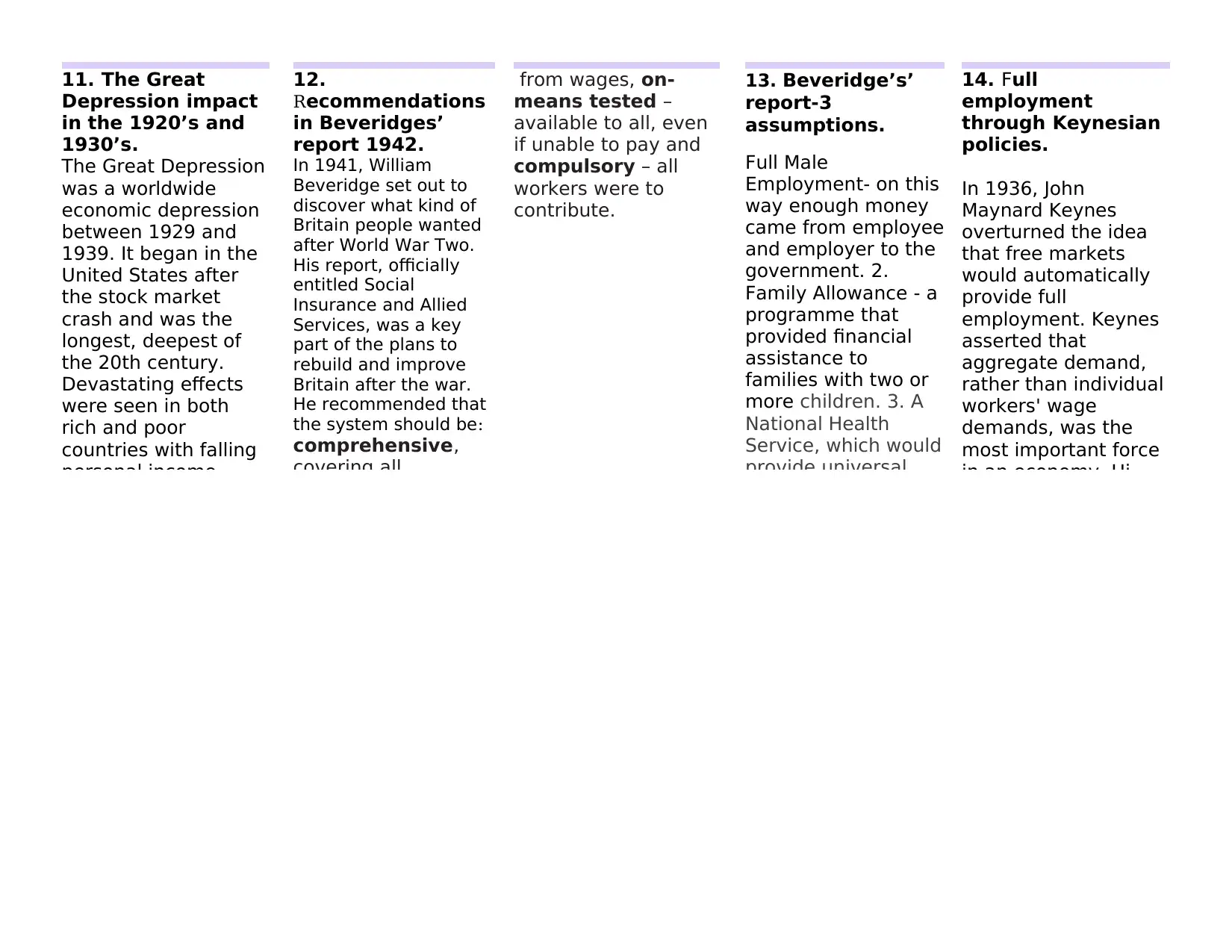
11. The Great
Depression impact
in the 1920’s and
1930’s.
The Great Depression
was a worldwide
economic depression
between 1929 and
1939. It began in the
United States after
the stock market
crash and was the
longest, deepest of
the 20th century.
Devastating effects
were seen in both
rich and poor
countries with falling
personal income,
12.
Recommendations
in Beveridges’
report 1942.
In 1941, William
Beveridge set out to
discover what kind of
Britain people wanted
after World War Two.
His report, officially
entitled Social
Insurance and Allied
Services, was a key
part of the plans to
rebuild and improve
Britain after the war.
He recommended that
the system should be:
comprehensive,
covering all
from wages, on-
means tested –
available to all, even
if unable to pay and
compulsory – all
workers were to
contribute.
13. Beveridge’s’
report-3
assumptions.
Full Male
Employment- on this
way enough money
came from employee
and employer to the
government. 2.
Family Allowance - a
programme that
provided financial
assistance to
families with two or
more children. 3. A
National Health
Service, which would
provide universal,
14. Full
employment
through Keynesian
policies.
In 1936, John
Maynard Keynes
overturned the idea
that free markets
would automatically
provide full
employment. Keynes
asserted that
aggregate demand,
rather than individual
workers' wage
demands, was the
most important force
in an economy. Hi
Depression impact
in the 1920’s and
1930’s.
The Great Depression
was a worldwide
economic depression
between 1929 and
1939. It began in the
United States after
the stock market
crash and was the
longest, deepest of
the 20th century.
Devastating effects
were seen in both
rich and poor
countries with falling
personal income,
12.
Recommendations
in Beveridges’
report 1942.
In 1941, William
Beveridge set out to
discover what kind of
Britain people wanted
after World War Two.
His report, officially
entitled Social
Insurance and Allied
Services, was a key
part of the plans to
rebuild and improve
Britain after the war.
He recommended that
the system should be:
comprehensive,
covering all
from wages, on-
means tested –
available to all, even
if unable to pay and
compulsory – all
workers were to
contribute.
13. Beveridge’s’
report-3
assumptions.
Full Male
Employment- on this
way enough money
came from employee
and employer to the
government. 2.
Family Allowance - a
programme that
provided financial
assistance to
families with two or
more children. 3. A
National Health
Service, which would
provide universal,
14. Full
employment
through Keynesian
policies.
In 1936, John
Maynard Keynes
overturned the idea
that free markets
would automatically
provide full
employment. Keynes
asserted that
aggregate demand,
rather than individual
workers' wage
demands, was the
most important force
in an economy. Hi
Secure Best Marks with AI Grader
Need help grading? Try our AI Grader for instant feedback on your assignments.
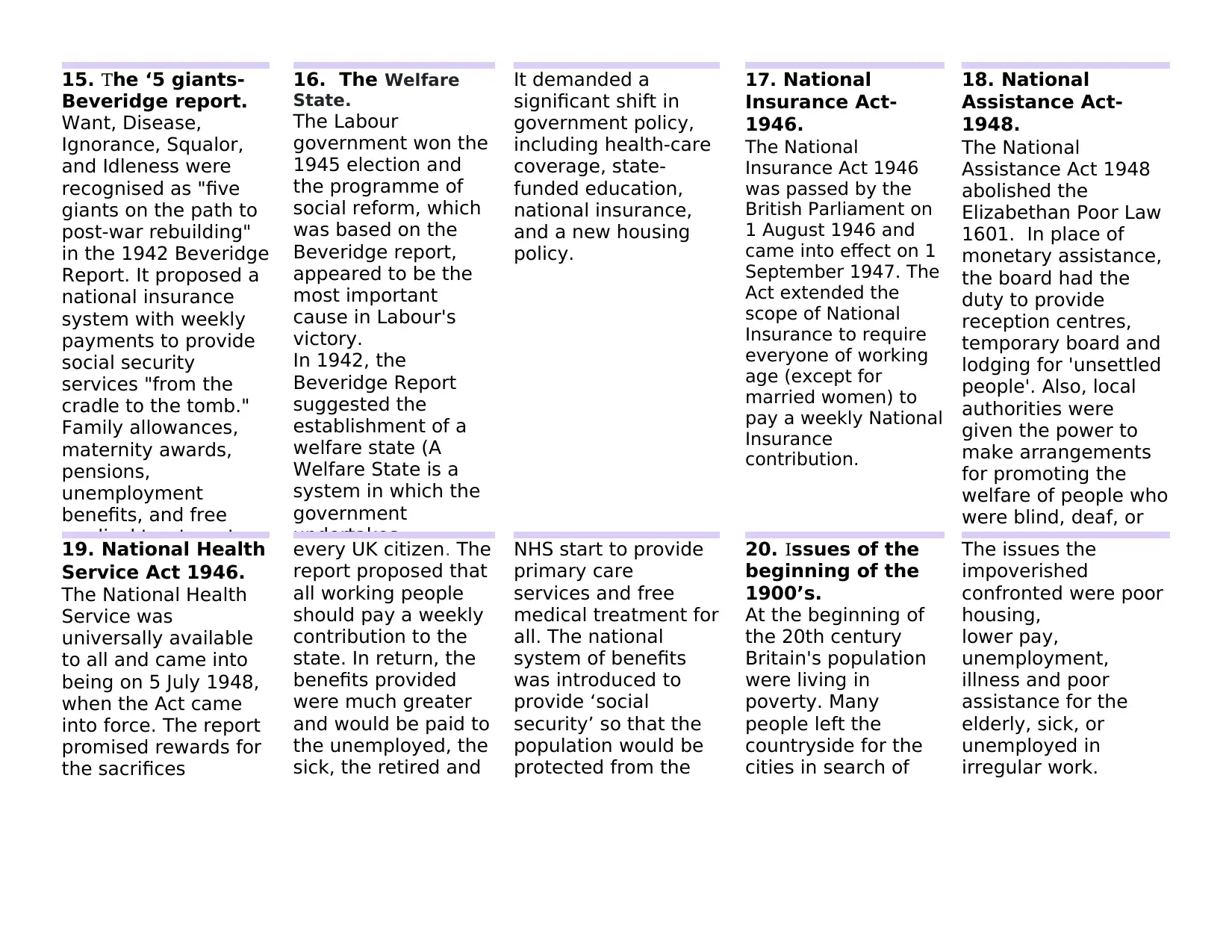
15. The ‘5 giants-
Beveridge report.
Want, Disease,
Ignorance, Squalor,
and Idleness were
recognised as "five
giants on the path to
post-war rebuilding"
in the 1942 Beveridge
Report. It proposed a
national insurance
system with weekly
payments to provide
social security
services "from the
cradle to the tomb."
Family allowances,
maternity awards,
pensions,
unemployment
benefits, and free
medical treatment
16. The Welfare
State.
The Labour
government won the
1945 election and
the programme of
social reform, which
was based on the
Beveridge report,
appeared to be the
most important
cause in Labour's
victory.
In 1942, the
Beveridge Report
suggested the
establishment of a
welfare state (A
Welfare State is a
system in which the
government
undertakes
It demanded a
significant shift in
government policy,
including health-care
coverage, state-
funded education,
national insurance,
and a new housing
policy.
17. National
Insurance Act-
1946.
The National
Insurance Act 1946
was passed by the
British Parliament on
1 August 1946 and
came into effect on 1
September 1947. The
Act extended the
scope of National
Insurance to require
everyone of working
age (except for
married women) to
pay a weekly National
Insurance
contribution.
18. National
Assistance Act-
1948.
The National
Assistance Act 1948
abolished the
Elizabethan Poor Law
1601. In place of
monetary assistance,
the board had the
duty to provide
reception centres,
temporary board and
lodging for 'unsettled
people'. Also, local
authorities were
given the power to
make arrangements
for promoting the
welfare of people who
were blind, deaf, or
disabled by illness or
19. National Health
Service Act 1946.
The National Health
Service was
universally available
to all and came into
being on 5 July 1948,
when the Act came
into force. The report
promised rewards for
the sacrifices
every UK citizen. The
report proposed that
all working people
should pay a weekly
contribution to the
state. In return, the
benefits provided
were much greater
and would be paid to
the unemployed, the
sick, the retired and
NHS start to provide
primary care
services and free
medical treatment for
all. The national
system of benefits
was introduced to
provide ‘social
security’ so that the
population would be
protected from the
20. Issues of the
beginning of the
1900’s.
At the beginning of
the 20th century
Britain's population
were living in
poverty. Many
people left the
countryside for the
cities in search of
The issues the
impoverished
confronted were poor
housing,
lower pay,
unemployment,
illness and poor
assistance for the
elderly, sick, or
unemployed in
irregular work.
Beveridge report.
Want, Disease,
Ignorance, Squalor,
and Idleness were
recognised as "five
giants on the path to
post-war rebuilding"
in the 1942 Beveridge
Report. It proposed a
national insurance
system with weekly
payments to provide
social security
services "from the
cradle to the tomb."
Family allowances,
maternity awards,
pensions,
unemployment
benefits, and free
medical treatment
16. The Welfare
State.
The Labour
government won the
1945 election and
the programme of
social reform, which
was based on the
Beveridge report,
appeared to be the
most important
cause in Labour's
victory.
In 1942, the
Beveridge Report
suggested the
establishment of a
welfare state (A
Welfare State is a
system in which the
government
undertakes
It demanded a
significant shift in
government policy,
including health-care
coverage, state-
funded education,
national insurance,
and a new housing
policy.
17. National
Insurance Act-
1946.
The National
Insurance Act 1946
was passed by the
British Parliament on
1 August 1946 and
came into effect on 1
September 1947. The
Act extended the
scope of National
Insurance to require
everyone of working
age (except for
married women) to
pay a weekly National
Insurance
contribution.
18. National
Assistance Act-
1948.
The National
Assistance Act 1948
abolished the
Elizabethan Poor Law
1601. In place of
monetary assistance,
the board had the
duty to provide
reception centres,
temporary board and
lodging for 'unsettled
people'. Also, local
authorities were
given the power to
make arrangements
for promoting the
welfare of people who
were blind, deaf, or
disabled by illness or
19. National Health
Service Act 1946.
The National Health
Service was
universally available
to all and came into
being on 5 July 1948,
when the Act came
into force. The report
promised rewards for
the sacrifices
every UK citizen. The
report proposed that
all working people
should pay a weekly
contribution to the
state. In return, the
benefits provided
were much greater
and would be paid to
the unemployed, the
sick, the retired and
NHS start to provide
primary care
services and free
medical treatment for
all. The national
system of benefits
was introduced to
provide ‘social
security’ so that the
population would be
protected from the
20. Issues of the
beginning of the
1900’s.
At the beginning of
the 20th century
Britain's population
were living in
poverty. Many
people left the
countryside for the
cities in search of
The issues the
impoverished
confronted were poor
housing,
lower pay,
unemployment,
illness and poor
assistance for the
elderly, sick, or
unemployed in
irregular work.
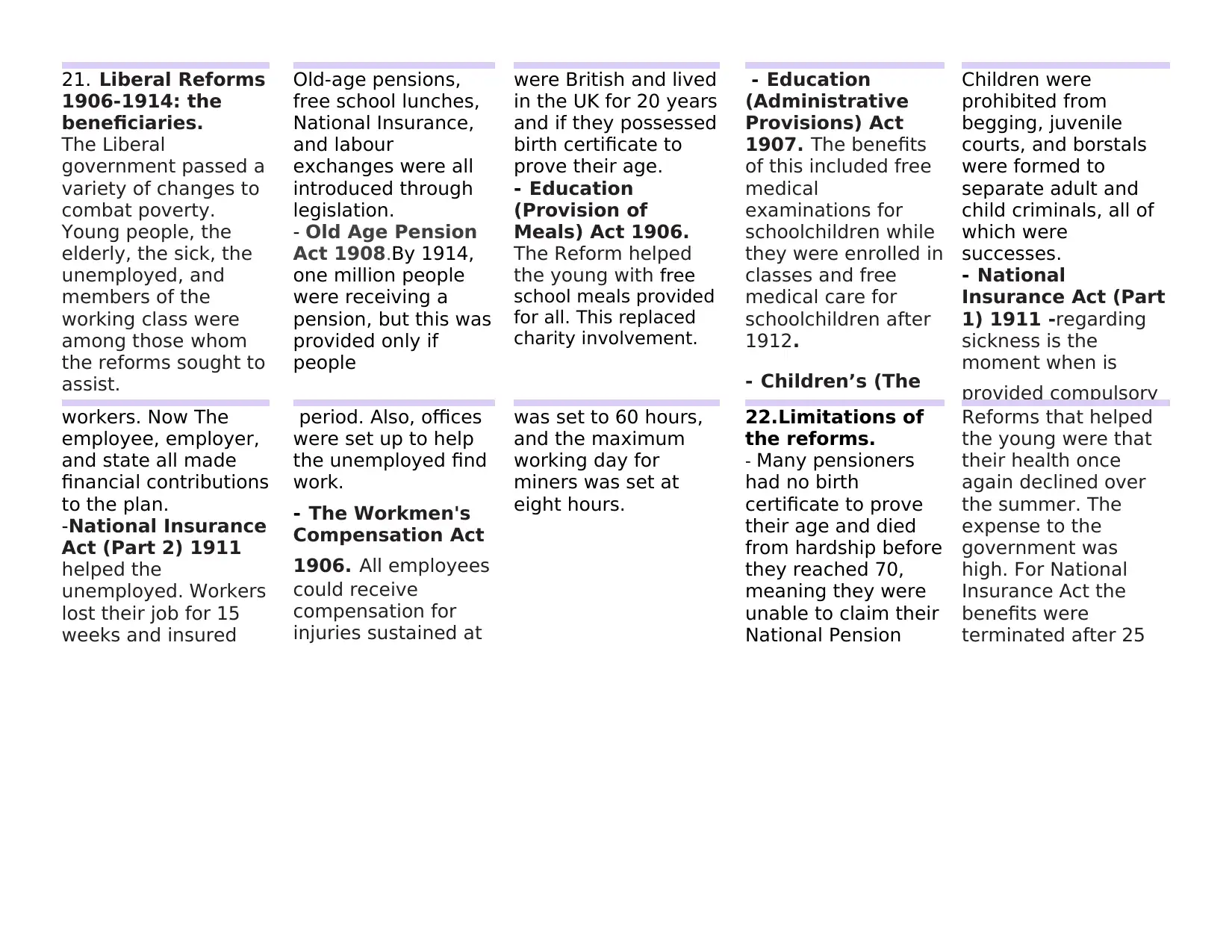
21. Liberal Reforms
1906-1914: the
beneficiaries.
The Liberal
government passed a
variety of changes to
combat poverty.
Young people, the
elderly, the sick, the
unemployed, and
members of the
working class were
among those whom
the reforms sought to
assist.
Old-age pensions,
free school lunches,
National Insurance,
and labour
exchanges were all
introduced through
legislation.
- Old Age Pension
Act 1908.By 1914,
one million people
were receiving a
pension, but this was
provided only if
people
were British and lived
in the UK for 20 years
and if they possessed
birth certificate to
prove their age.
- Education
(Provision of
Meals) Act 1906.
The Reform helped
the young with free
school meals provided
for all. This replaced
charity involvement.
- Education
(Administrative
Provisions) Act
1907. The benefits
of this included free
medical
examinations for
schoolchildren while
they were enrolled in
classes and free
medical care for
schoolchildren after
1912.
- Children’s (The
Children's
Children were
prohibited from
begging, juvenile
courts, and borstals
were formed to
separate adult and
child criminals, all of
which were
successes.
- National
Insurance Act (Part
1) 1911 -regarding
sickness is the
moment when is
provided compulsory
workers. Now The
employee, employer,
and state all made
financial contributions
to the plan.
-National Insurance
Act (Part 2) 1911
helped the
unemployed. Workers
lost their job for 15
weeks and insured
period. Also, offices
were set up to help
the unemployed find
work.
- The Workmen's
Compensation Act
1906. All employees
could receive
compensation for
injuries sustained at
work. The maximum
was set to 60 hours,
and the maximum
working day for
miners was set at
eight hours.
22.Limitations of
the reforms.
- Many pensioners
had no birth
certificate to prove
their age and died
from hardship before
they reached 70,
meaning they were
unable to claim their
National Pension
Reforms that helped
the young were that
their health once
again declined over
the summer. The
expense to the
government was
high. For National
Insurance Act the
benefits were
terminated after 25
1906-1914: the
beneficiaries.
The Liberal
government passed a
variety of changes to
combat poverty.
Young people, the
elderly, the sick, the
unemployed, and
members of the
working class were
among those whom
the reforms sought to
assist.
Old-age pensions,
free school lunches,
National Insurance,
and labour
exchanges were all
introduced through
legislation.
- Old Age Pension
Act 1908.By 1914,
one million people
were receiving a
pension, but this was
provided only if
people
were British and lived
in the UK for 20 years
and if they possessed
birth certificate to
prove their age.
- Education
(Provision of
Meals) Act 1906.
The Reform helped
the young with free
school meals provided
for all. This replaced
charity involvement.
- Education
(Administrative
Provisions) Act
1907. The benefits
of this included free
medical
examinations for
schoolchildren while
they were enrolled in
classes and free
medical care for
schoolchildren after
1912.
- Children’s (The
Children's
Children were
prohibited from
begging, juvenile
courts, and borstals
were formed to
separate adult and
child criminals, all of
which were
successes.
- National
Insurance Act (Part
1) 1911 -regarding
sickness is the
moment when is
provided compulsory
workers. Now The
employee, employer,
and state all made
financial contributions
to the plan.
-National Insurance
Act (Part 2) 1911
helped the
unemployed. Workers
lost their job for 15
weeks and insured
period. Also, offices
were set up to help
the unemployed find
work.
- The Workmen's
Compensation Act
1906. All employees
could receive
compensation for
injuries sustained at
work. The maximum
was set to 60 hours,
and the maximum
working day for
miners was set at
eight hours.
22.Limitations of
the reforms.
- Many pensioners
had no birth
certificate to prove
their age and died
from hardship before
they reached 70,
meaning they were
unable to claim their
National Pension
Reforms that helped
the young were that
their health once
again declined over
the summer. The
expense to the
government was
high. For National
Insurance Act the
benefits were
terminated after 25
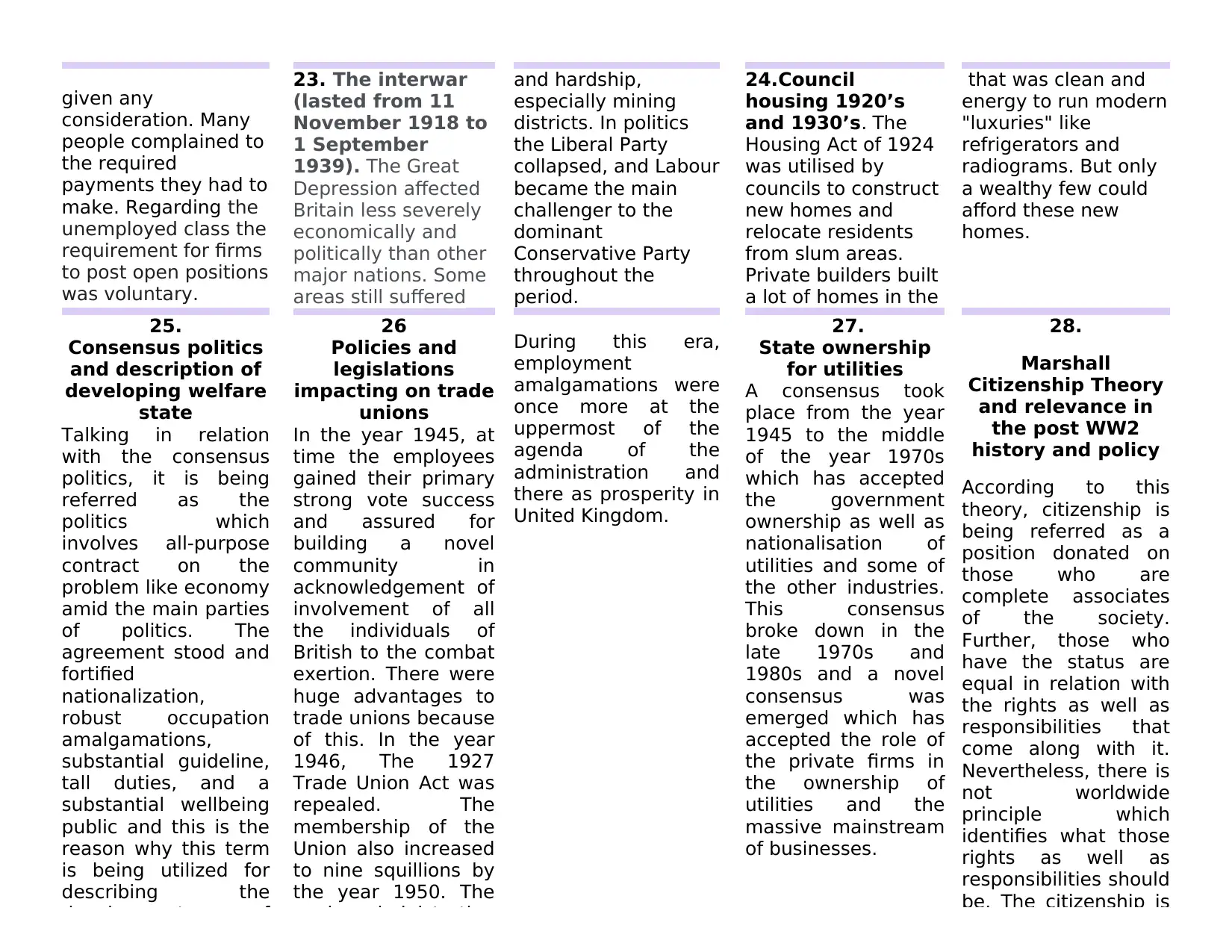
given any
consideration. Many
people complained to
the required
payments they had to
make. Regarding the
unemployed class the
requirement for firms
to post open positions
was voluntary.
23. The interwar
(lasted from 11
November 1918 to
1 September
1939). The Great
Depression affected
Britain less severely
economically and
politically than other
major nations. Some
areas still suffered
and hardship,
especially mining
districts. In politics
the Liberal Party
collapsed, and Labour
became the main
challenger to the
dominant
Conservative Party
throughout the
period.
24.Council
housing 1920’s
and 1930’s. The
Housing Act of 1924
was utilised by
councils to construct
new homes and
relocate residents
from slum areas.
Private builders built
a lot of homes in the
that was clean and
energy to run modern
"luxuries" like
refrigerators and
radiograms. But only
a wealthy few could
afford these new
homes.
25.
Consensus politics
and description of
developing welfare
state
Talking in relation
with the consensus
politics, it is being
referred as the
politics which
involves all-purpose
contract on the
problem like economy
amid the main parties
of politics. The
agreement stood and
fortified
nationalization,
robust occupation
amalgamations,
substantial guideline,
tall duties, and a
substantial wellbeing
public and this is the
reason why this term
is being utilized for
describing the
development of
26
Policies and
legislations
impacting on trade
unions
In the year 1945, at
time the employees
gained their primary
strong vote success
and assured for
building a novel
community in
acknowledgement of
involvement of all
the individuals of
British to the combat
exertion. There were
huge advantages to
trade unions because
of this. In the year
1946, The 1927
Trade Union Act was
repealed. The
membership of the
Union also increased
to nine squillions by
the year 1950. The
work administration
During this era,
employment
amalgamations were
once more at the
uppermost of the
agenda of the
administration and
there as prosperity in
United Kingdom.
27.
State ownership
for utilities
A consensus took
place from the year
1945 to the middle
of the year 1970s
which has accepted
the government
ownership as well as
nationalisation of
utilities and some of
the other industries.
This consensus
broke down in the
late 1970s and
1980s and a novel
consensus was
emerged which has
accepted the role of
the private firms in
the ownership of
utilities and the
massive mainstream
of businesses.
28.
Marshall
Citizenship Theory
and relevance in
the post WW2
history and policy
According to this
theory, citizenship is
being referred as a
position donated on
those who are
complete associates
of the society.
Further, those who
have the status are
equal in relation with
the rights as well as
responsibilities that
come along with it.
Nevertheless, there is
not worldwide
principle which
identifies what those
rights as well as
responsibilities should
be. The citizenship is
consideration. Many
people complained to
the required
payments they had to
make. Regarding the
unemployed class the
requirement for firms
to post open positions
was voluntary.
23. The interwar
(lasted from 11
November 1918 to
1 September
1939). The Great
Depression affected
Britain less severely
economically and
politically than other
major nations. Some
areas still suffered
and hardship,
especially mining
districts. In politics
the Liberal Party
collapsed, and Labour
became the main
challenger to the
dominant
Conservative Party
throughout the
period.
24.Council
housing 1920’s
and 1930’s. The
Housing Act of 1924
was utilised by
councils to construct
new homes and
relocate residents
from slum areas.
Private builders built
a lot of homes in the
that was clean and
energy to run modern
"luxuries" like
refrigerators and
radiograms. But only
a wealthy few could
afford these new
homes.
25.
Consensus politics
and description of
developing welfare
state
Talking in relation
with the consensus
politics, it is being
referred as the
politics which
involves all-purpose
contract on the
problem like economy
amid the main parties
of politics. The
agreement stood and
fortified
nationalization,
robust occupation
amalgamations,
substantial guideline,
tall duties, and a
substantial wellbeing
public and this is the
reason why this term
is being utilized for
describing the
development of
26
Policies and
legislations
impacting on trade
unions
In the year 1945, at
time the employees
gained their primary
strong vote success
and assured for
building a novel
community in
acknowledgement of
involvement of all
the individuals of
British to the combat
exertion. There were
huge advantages to
trade unions because
of this. In the year
1946, The 1927
Trade Union Act was
repealed. The
membership of the
Union also increased
to nine squillions by
the year 1950. The
work administration
During this era,
employment
amalgamations were
once more at the
uppermost of the
agenda of the
administration and
there as prosperity in
United Kingdom.
27.
State ownership
for utilities
A consensus took
place from the year
1945 to the middle
of the year 1970s
which has accepted
the government
ownership as well as
nationalisation of
utilities and some of
the other industries.
This consensus
broke down in the
late 1970s and
1980s and a novel
consensus was
emerged which has
accepted the role of
the private firms in
the ownership of
utilities and the
massive mainstream
of businesses.
28.
Marshall
Citizenship Theory
and relevance in
the post WW2
history and policy
According to this
theory, citizenship is
being referred as a
position donated on
those who are
complete associates
of the society.
Further, those who
have the status are
equal in relation with
the rights as well as
responsibilities that
come along with it.
Nevertheless, there is
not worldwide
principle which
identifies what those
rights as well as
responsibilities should
be. The citizenship is
Paraphrase This Document
Need a fresh take? Get an instant paraphrase of this document with our AI Paraphraser
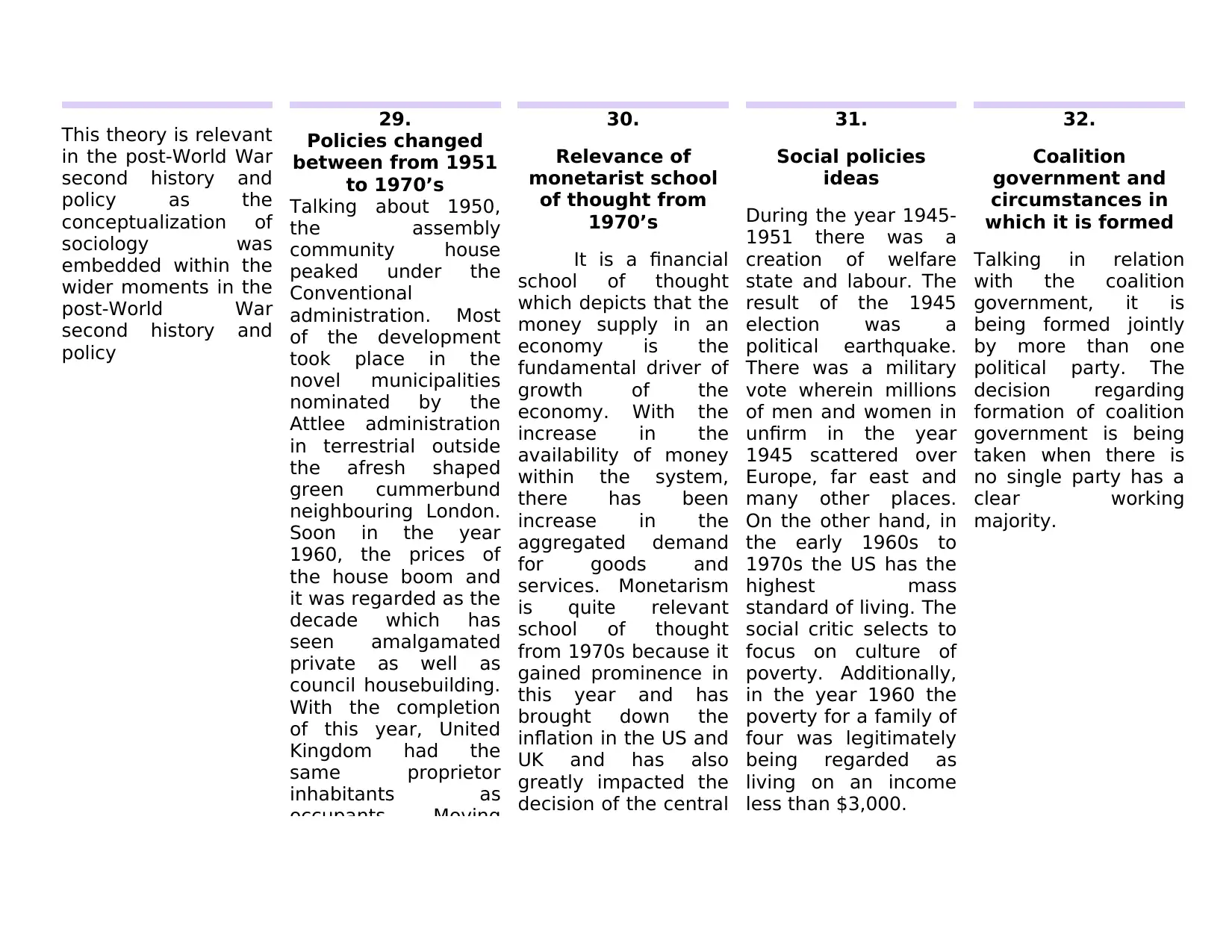
This theory is relevant
in the post-World War
second history and
policy as the
conceptualization of
sociology was
embedded within the
wider moments in the
post-World War
second history and
policy
29.
Policies changed
between from 1951
to 1970’s
Talking about 1950,
the assembly
community house
peaked under the
Conventional
administration. Most
of the development
took place in the
novel municipalities
nominated by the
Attlee administration
in terrestrial outside
the afresh shaped
green cummerbund
neighbouring London.
Soon in the year
1960, the prices of
the house boom and
it was regarded as the
decade which has
seen amalgamated
private as well as
council housebuilding.
With the completion
of this year, United
Kingdom had the
same proprietor
inhabitants as
occupants. Moving
30.
Relevance of
monetarist school
of thought from
1970’s
It is a financial
school of thought
which depicts that the
money supply in an
economy is the
fundamental driver of
growth of the
economy. With the
increase in the
availability of money
within the system,
there has been
increase in the
aggregated demand
for goods and
services. Monetarism
is quite relevant
school of thought
from 1970s because it
gained prominence in
this year and has
brought down the
inflation in the US and
UK and has also
greatly impacted the
decision of the central
bank of US for
31.
Social policies
ideas
During the year 1945-
1951 there was a
creation of welfare
state and labour. The
result of the 1945
election was a
political earthquake.
There was a military
vote wherein millions
of men and women in
unfirm in the year
1945 scattered over
Europe, far east and
many other places.
On the other hand, in
the early 1960s to
1970s the US has the
highest mass
standard of living. The
social critic selects to
focus on culture of
poverty. Additionally,
in the year 1960 the
poverty for a family of
four was legitimately
being regarded as
living on an income
less than $3,000.
32.
Coalition
government and
circumstances in
which it is formed
Talking in relation
with the coalition
government, it is
being formed jointly
by more than one
political party. The
decision regarding
formation of coalition
government is being
taken when there is
no single party has a
clear working
majority.
in the post-World War
second history and
policy as the
conceptualization of
sociology was
embedded within the
wider moments in the
post-World War
second history and
policy
29.
Policies changed
between from 1951
to 1970’s
Talking about 1950,
the assembly
community house
peaked under the
Conventional
administration. Most
of the development
took place in the
novel municipalities
nominated by the
Attlee administration
in terrestrial outside
the afresh shaped
green cummerbund
neighbouring London.
Soon in the year
1960, the prices of
the house boom and
it was regarded as the
decade which has
seen amalgamated
private as well as
council housebuilding.
With the completion
of this year, United
Kingdom had the
same proprietor
inhabitants as
occupants. Moving
30.
Relevance of
monetarist school
of thought from
1970’s
It is a financial
school of thought
which depicts that the
money supply in an
economy is the
fundamental driver of
growth of the
economy. With the
increase in the
availability of money
within the system,
there has been
increase in the
aggregated demand
for goods and
services. Monetarism
is quite relevant
school of thought
from 1970s because it
gained prominence in
this year and has
brought down the
inflation in the US and
UK and has also
greatly impacted the
decision of the central
bank of US for
31.
Social policies
ideas
During the year 1945-
1951 there was a
creation of welfare
state and labour. The
result of the 1945
election was a
political earthquake.
There was a military
vote wherein millions
of men and women in
unfirm in the year
1945 scattered over
Europe, far east and
many other places.
On the other hand, in
the early 1960s to
1970s the US has the
highest mass
standard of living. The
social critic selects to
focus on culture of
poverty. Additionally,
in the year 1960 the
poverty for a family of
four was legitimately
being regarded as
living on an income
less than $3,000.
32.
Coalition
government and
circumstances in
which it is formed
Talking in relation
with the coalition
government, it is
being formed jointly
by more than one
political party. The
decision regarding
formation of coalition
government is being
taken when there is
no single party has a
clear working
majority.
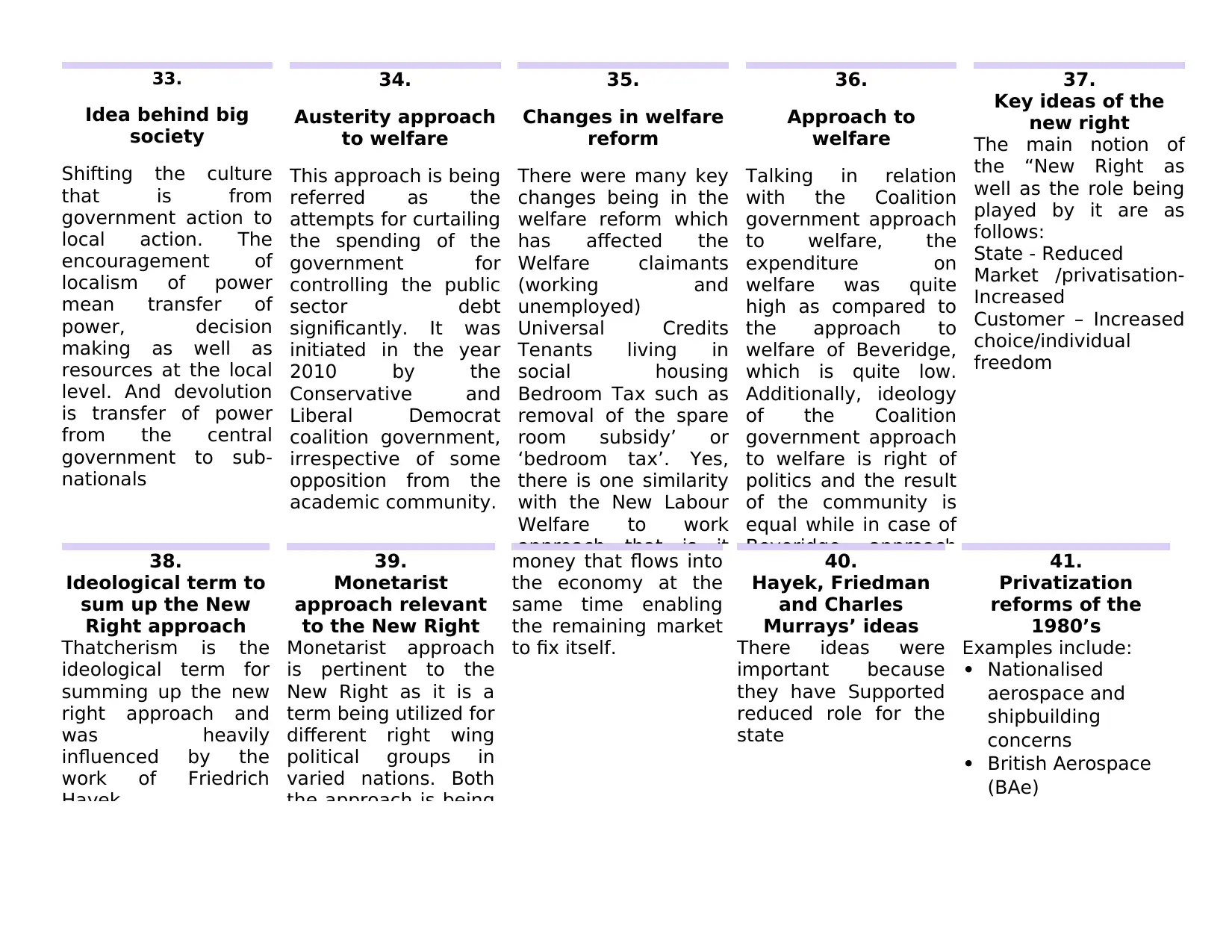
33.
Idea behind big
society
Shifting the culture
that is from
government action to
local action. The
encouragement of
localism of power
mean transfer of
power, decision
making as well as
resources at the local
level. And devolution
is transfer of power
from the central
government to sub-
nationals
34.
Austerity approach
to welfare
This approach is being
referred as the
attempts for curtailing
the spending of the
government for
controlling the public
sector debt
significantly. It was
initiated in the year
2010 by the
Conservative and
Liberal Democrat
coalition government,
irrespective of some
opposition from the
academic community.
35.
Changes in welfare
reform
There were many key
changes being in the
welfare reform which
has affected the
Welfare claimants
(working and
unemployed)
Universal Credits
Tenants living in
social housing
Bedroom Tax such as
removal of the spare
room subsidy’ or
‘bedroom tax’. Yes,
there is one similarity
with the New Labour
Welfare to work
approach that is it
36.
Approach to
welfare
Talking in relation
with the Coalition
government approach
to welfare, the
expenditure on
welfare was quite
high as compared to
the approach to
welfare of Beveridge,
which is quite low.
Additionally, ideology
of the Coalition
government approach
to welfare is right of
politics and the result
of the community is
equal while in case of
Beveridge approach
37.
Key ideas of the
new right
The main notion of
the “New Right as
well as the role being
played by it are as
follows:
State - Reduced
Market /privatisation-
Increased
Customer – Increased
choice/individual
freedom
38.
Ideological term to
sum up the New
Right approach
Thatcherism is the
ideological term for
summing up the new
right approach and
was heavily
influenced by the
work of Friedrich
Hayek
39.
Monetarist
approach relevant
to the New Right
Monetarist approach
is pertinent to the
New Right as it is a
term being utilized for
different right wing
political groups in
varied nations. Both
the approach is being
money that flows into
the economy at the
same time enabling
the remaining market
to fix itself.
40.
Hayek, Friedman
and Charles
Murrays’ ideas
There ideas were
important because
they have Supported
reduced role for the
state
41.
Privatization
reforms of the
1980’s
Examples include:
Nationalised
aerospace and
shipbuilding
concerns
British Aerospace
(BAe)
Nuclear research
Idea behind big
society
Shifting the culture
that is from
government action to
local action. The
encouragement of
localism of power
mean transfer of
power, decision
making as well as
resources at the local
level. And devolution
is transfer of power
from the central
government to sub-
nationals
34.
Austerity approach
to welfare
This approach is being
referred as the
attempts for curtailing
the spending of the
government for
controlling the public
sector debt
significantly. It was
initiated in the year
2010 by the
Conservative and
Liberal Democrat
coalition government,
irrespective of some
opposition from the
academic community.
35.
Changes in welfare
reform
There were many key
changes being in the
welfare reform which
has affected the
Welfare claimants
(working and
unemployed)
Universal Credits
Tenants living in
social housing
Bedroom Tax such as
removal of the spare
room subsidy’ or
‘bedroom tax’. Yes,
there is one similarity
with the New Labour
Welfare to work
approach that is it
36.
Approach to
welfare
Talking in relation
with the Coalition
government approach
to welfare, the
expenditure on
welfare was quite
high as compared to
the approach to
welfare of Beveridge,
which is quite low.
Additionally, ideology
of the Coalition
government approach
to welfare is right of
politics and the result
of the community is
equal while in case of
Beveridge approach
37.
Key ideas of the
new right
The main notion of
the “New Right as
well as the role being
played by it are as
follows:
State - Reduced
Market /privatisation-
Increased
Customer – Increased
choice/individual
freedom
38.
Ideological term to
sum up the New
Right approach
Thatcherism is the
ideological term for
summing up the new
right approach and
was heavily
influenced by the
work of Friedrich
Hayek
39.
Monetarist
approach relevant
to the New Right
Monetarist approach
is pertinent to the
New Right as it is a
term being utilized for
different right wing
political groups in
varied nations. Both
the approach is being
money that flows into
the economy at the
same time enabling
the remaining market
to fix itself.
40.
Hayek, Friedman
and Charles
Murrays’ ideas
There ideas were
important because
they have Supported
reduced role for the
state
41.
Privatization
reforms of the
1980’s
Examples include:
Nationalised
aerospace and
shipbuilding
concerns
British Aerospace
(BAe)
Nuclear research

Amersham
International
and half of
Cable and
Wireless
42.
Privatization
reforms of the
1980’s replaced
state welfare
The privatization
reforms of the 1980’s
replaced the state
welfare with private
provision and the
example includes
replacing the
prosperity, channels
public dollars into
private hand etc.
43.
Effects of the New
Right Policies
The new right policies
have impacted the
British politics,
welfare and social
policies of the
Thatcher government
and conservative
social policies.
44.
Founding
principles and New
Right approach
Both have comprised
the idea of equality
which depicts a
redistributive justice
of collective
solidarity.
45.
Anthony Giddens
political thinking
It is important
because it helped in
shaping those policies
being executed by
New Labour
International
and half of
Cable and
Wireless
42.
Privatization
reforms of the
1980’s replaced
state welfare
The privatization
reforms of the 1980’s
replaced the state
welfare with private
provision and the
example includes
replacing the
prosperity, channels
public dollars into
private hand etc.
43.
Effects of the New
Right Policies
The new right policies
have impacted the
British politics,
welfare and social
policies of the
Thatcher government
and conservative
social policies.
44.
Founding
principles and New
Right approach
Both have comprised
the idea of equality
which depicts a
redistributive justice
of collective
solidarity.
45.
Anthony Giddens
political thinking
It is important
because it helped in
shaping those policies
being executed by
New Labour
Secure Best Marks with AI Grader
Need help grading? Try our AI Grader for instant feedback on your assignments.
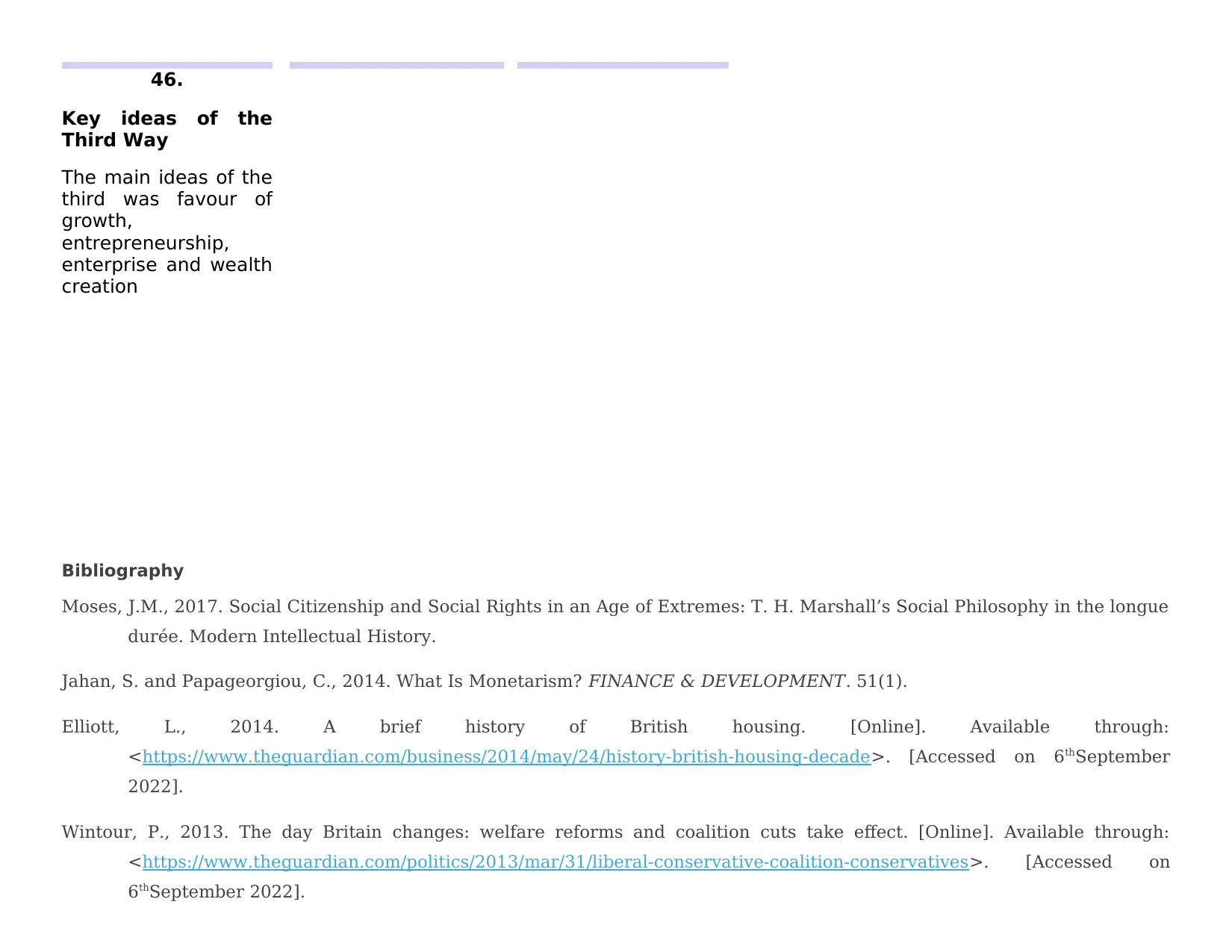
46.
Key ideas of the
Third Way
The main ideas of the
third was favour of
growth,
entrepreneurship,
enterprise and wealth
creation
Bibliography
Moses, J.M., 2017. Social Citizenship and Social Rights in an Age of Extremes: T. H. Marshall’s Social Philosophy in the longue
durée. Modern Intellectual History.
Jahan, S. and Papageorgiou, C., 2014. What Is Monetarism? FINANCE & DEVELOPMENT. 51(1).
Elliott, L., 2014. A brief history of British housing. [Online]. Available through:
<https://www.theguardian.com/business/2014/may/24/history-british-housing-decade>. [Accessed on 6thSeptember
2022].
Wintour, P., 2013. The day Britain changes: welfare reforms and coalition cuts take effect. [Online]. Available through:
<https://www.theguardian.com/politics/2013/mar/31/liberal-conservative-coalition-conservatives>. [Accessed on
6thSeptember 2022].
Key ideas of the
Third Way
The main ideas of the
third was favour of
growth,
entrepreneurship,
enterprise and wealth
creation
Bibliography
Moses, J.M., 2017. Social Citizenship and Social Rights in an Age of Extremes: T. H. Marshall’s Social Philosophy in the longue
durée. Modern Intellectual History.
Jahan, S. and Papageorgiou, C., 2014. What Is Monetarism? FINANCE & DEVELOPMENT. 51(1).
Elliott, L., 2014. A brief history of British housing. [Online]. Available through:
<https://www.theguardian.com/business/2014/may/24/history-british-housing-decade>. [Accessed on 6thSeptember
2022].
Wintour, P., 2013. The day Britain changes: welfare reforms and coalition cuts take effect. [Online]. Available through:
<https://www.theguardian.com/politics/2013/mar/31/liberal-conservative-coalition-conservatives>. [Accessed on
6thSeptember 2022].
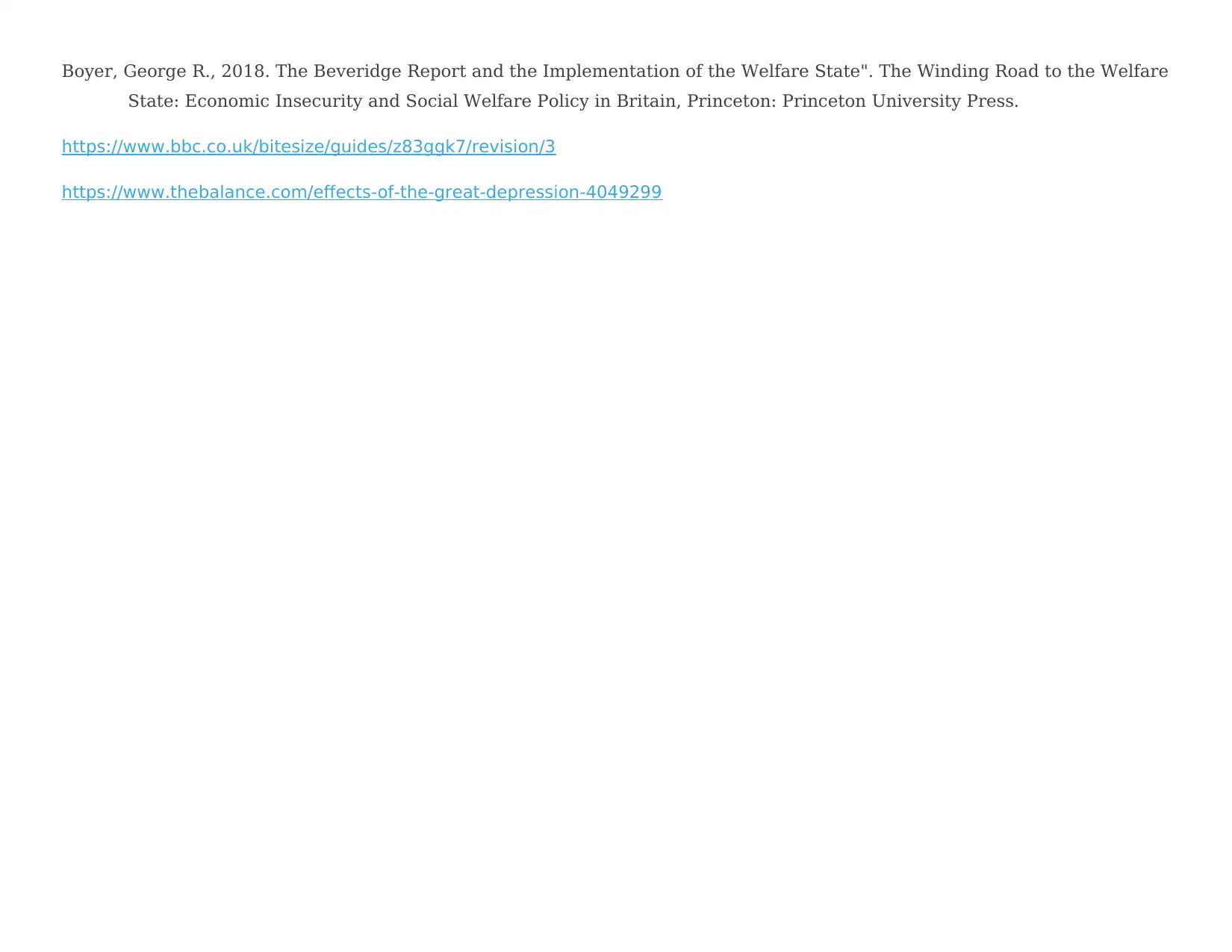
Boyer, George R., 2018. The Beveridge Report and the Implementation of the Welfare State". The Winding Road to the Welfare
State: Economic Insecurity and Social Welfare Policy in Britain, Princeton: Princeton University Press.
https://www.bbc.co.uk/bitesize/guides/z83ggk7/revision/3
https://www.thebalance.com/effects-of-the-great-depression-4049299
State: Economic Insecurity and Social Welfare Policy in Britain, Princeton: Princeton University Press.
https://www.bbc.co.uk/bitesize/guides/z83ggk7/revision/3
https://www.thebalance.com/effects-of-the-great-depression-4049299
1 out of 12
Related Documents
Your All-in-One AI-Powered Toolkit for Academic Success.
+13062052269
info@desklib.com
Available 24*7 on WhatsApp / Email
![[object Object]](/_next/static/media/star-bottom.7253800d.svg)
Unlock your academic potential
© 2024 | Zucol Services PVT LTD | All rights reserved.



